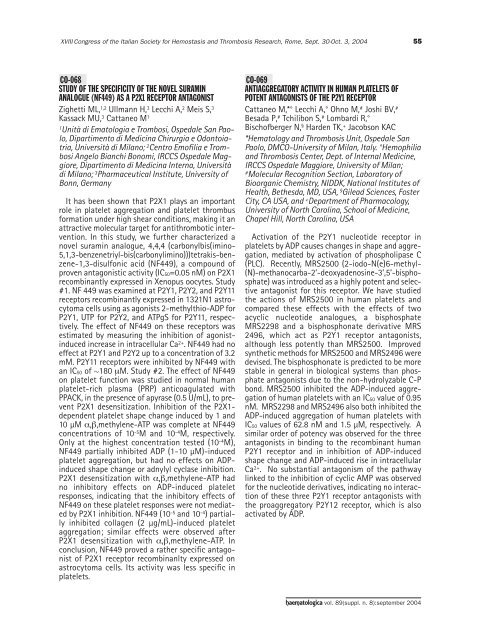Haematologica 2004;89: supplement no. 8 - Supplements ...
Haematologica 2004;89: supplement no. 8 - Supplements ...
Haematologica 2004;89: supplement no. 8 - Supplements ...
- No tags were found...
You also want an ePaper? Increase the reach of your titles
YUMPU automatically turns print PDFs into web optimized ePapers that Google loves.
XVIII Congress of the Italian Society for Hemostasis and Thrombosis Research, Rome, Sept. 30-Oct. 3, <strong>2004</strong>55CO-068STUDY OF THE SPECIFICITY OF THE NOVEL SURAMINANALOGUE (NF449) AS A P2X1 RECEPTOR ANTAGONISTZighetti ML, 1,2 Ullmann H, 3 Lecchi A, 2 Meis S, 3Kassack MU, 3 Cattaneo M 11Unità di Ematologia e Trombosi, Ospedale San Paolo,Dipartimento di Medicina Chirurgia e Odontoiatria,Università di Mila<strong>no</strong>; 2 Centro Emofilia e TrombosiAngelo Bianchi Bo<strong>no</strong>mi, IRCCS Ospedale Maggiore,Dipartimento di Medicina Interna, Universitàdi Mila<strong>no</strong>; 3 Pharmaceutical Institute, University ofBonn, GermanyIt has been shown that P2X1 plays an importantrole in platelet aggregation and platelet thrombusformation under high shear conditions, making it anattractive molecular target for antithrombotic intervention.In this study, we further characterized a<strong>no</strong>vel suramin analogue, 4,4,4 (carbonylbis(imi<strong>no</strong>-5,1,3-benzenetriyl-bis(carbonylimi<strong>no</strong>)))tetrakis-benzene-1,3-disulfonicacid (NF449), a compound ofproven antagonistic activity (IC50=0.05 nM) on P2X1recombinantly expressed in Xe<strong>no</strong>pus oocytes. Study#1. NF 449 was examined at P2Y1, P2Y2, and P2Y11receptors recombinantly expressed in 1321N1 astrocytomacells using as agonists 2-methylthio-ADP forP2Y1, UTP for P2Y2, and ATPgS for P2Y11, respectively.The effect of NF449 on these receptors wasestimated by measuring the inhibition of agonistinducedincrease in intracellular Ca 2+ . NF449 had <strong>no</strong>effect at P2Y1 and P2Y2 up to a concentration of 3.2mM. P2Y11 receptors were inhibited by NF449 withan IC50 of ~180 µM. Study #2. The effect of NF449on platelet function was studied in <strong>no</strong>rmal humanplatelet-rich plasma (PRP) anticoagulated withPPACK, in the presence of apyrase (0.5 U/mL), to preventP2X1 desensitization. Inhibition of the P2X1-dependent platelet shape change induced by 1 and10 µM α,β,methylene-ATP was complete at NF449concentrations of 10 -5 M and 10 -4 M, respectively.Only at the highest concentration tested (10 -4 M),NF449 partially inhibited ADP (1-10 µM)-inducedplatelet aggregation, but had <strong>no</strong> effects on ADPinducedshape change or adnylyl cyclase inhibition.P2X1 desensitization with α,β,methylene-ATP had<strong>no</strong> inhibitory effects on ADP-induced plateletresponses, indicating that the inhibitory effects ofNF449 on these platelet responses were <strong>no</strong>t mediatedby P2X1 inhibition. NF449 (10 -5 and 10 -4 ) partiallyinhibited collagen (2 µg/mL)-induced plateletaggregation; similar effects were observed afterP2X1 desensitization with α,β,methylene-ATP. Inconclusion, NF449 proved a rather specific antagonistof P2X1 receptor recombinanlty expressed onastrocytoma cells. Its activity was less specific inplatelets.CO-069ANTIAGGREGATORY ACTIVITY IN HUMAN PLATELETS OFPOTENT ANTAGONISTS OF THE P2Y1 RECEPTORCattaneo M,*° Lecchi A,° Oh<strong>no</strong> M, # Joshi BV, #Besada P, # Tchilibon S, # Lombardi R,°Bischofberger N, § Harden TK, + Jacobson KAC*Hematology and Thrombosis Unit, Ospedale SanPaolo, DMCO-University of Milan, Italy. °Hemophiliaand Thrombosis Center, Dept. of Internal Medicine,IRCCS Ospedale Maggiore, University of Milan;#Molecular Recognition Section, Laboratory ofBioorganic Chemistry, NIDDK, National Institutes ofHealth, Bethesda, MD, USA, § Gilead Sciences, FosterCity, CA USA, and + Department of Pharmacology,University of North Carolina, School of Medicine,Chapel Hill, North Carolina, USAActivation of the P2Y1 nucleotide receptor inplatelets by ADP causes changes in shape and aggregation,mediated by activation of phospholipase C(PLC). Recently, MRS2500 (2-iodo-N(e)6-methyl-(N)-metha<strong>no</strong>carba-2’-deoxyade<strong>no</strong>sine-3’,5’-bisphosphate)was introduced as a highly potent and selectiveantagonist for this receptor. We have studiedthe actions of MRS2500 in human platelets andcompared these effects with the effects of twoacyclic nucleotide analogues, a bisphosphateMRS2298 and a bisphosphonate derivative MRS2496, which act as P2Y1 receptor antagonists,although less potently than MRS2500. Improvedsynthetic methods for MRS2500 and MRS2496 weredevised. The bisphosphonate is predicted to be morestable in general in biological systems than phosphateantagonists due to the <strong>no</strong>n-hydrolyzable C-Pbond. MRS2500 inhibited the ADP-induced aggregatio<strong>no</strong>f human platelets with an IC50 value of 0.95nM. MRS2298 and MRS2496 also both inhibited theADP-induced aggregation of human platelets withIC50 values of 62.8 nM and 1.5 µM, respectively. Asimilar order of potency was observed for the threeantagonists in binding to the recombinant humanP2Y1 receptor and in inhibition of ADP-inducedshape change and ADP-induced rise in intracellularCa 2+ . No substantial antagonism of the pathwaylinked to the inhibition of cyclic AMP was observedfor the nucleotide derivatives, indicating <strong>no</strong> interactio<strong>no</strong>f these three P2Y1 receptor antagonists withthe proaggregatory P2Y12 receptor, which is alsoactivated by ADP.haematologica vol. <strong>89</strong>(suppl. n. 8):september <strong>2004</strong>
















